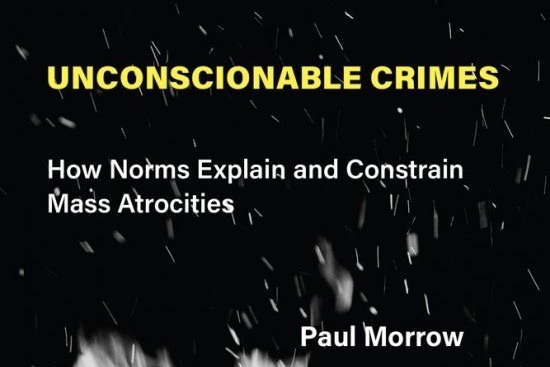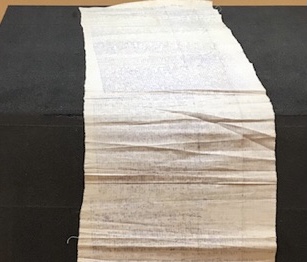Let's Talk Human Rights

Interview With HRC Postdoc Paul Morrow On Mass Atrocities and Advocacy
In September 2020, HRC Postdoc Paul Morrow published his book Unconscionable Crimes: How Norms Explain and Constrain Mass Atrocities (MIT Press). On 26 February 2021, the book will be formally launched at an event with guest speaker Jonathan Leader Maynard of King’s College London. In anticipation of this event, HRC Senior Researcher Alexandra Budabin sat down with Paul to learn more about his work and its application to the study and practice of advocacy.
Alexandra: Making sense of mass atrocity is an enormous but necessary task. What led you to focus your research on this issue, and how does your training in philosophy shape your work?
Paul: Like most researchers in this field, I can remember being shocked by images and narratives of historical atrocities during my childhood, as well as being exposed to events like the Rwandan genocide, which happened when I was nine. In college, I took courses in ethics, political philosophy and Holocaust studies, reading authors like Hannah Arendt, Theodore Adorno and Immanuel Kant. All of these authors are concerned, at some level, with the problem of grave human wrongdoing.
Graduate school allowed me to go deeper into the scholarship on mass atrocity. Philosophy, my discipline, is not as widely represented as some others in this field. But I think philosophy is well suited to the study of mass atrocities. Such events raise both explanatory and evaluative questions: on the one hand, we struggle to make sense of how such things happen in the world; on the other hand, we struggle to determine how we should respond to them. Philosophers are used to thinking about both of these kinds of questions.
Alexandra: Tell us a bit more about your research process. Were there any memorable moments in the preparation of this book? Any artifacts or stories that you uncovered which shaped your argument?
Paul: My research required me to take on two tasks. The first task was to survey the philosophical literature on norms, spread across work in ethics, philosophy of law and philosophy of social science, and to see how findings from that literature can inform historical and social scientific studies of mass atrocity. Research here consisted of reading books and articles, attending conferences and talking with scholars in the field.
The second task was to study primary sources on historical mass atrocities, in order to understand the decisions and actions that particular individuals have made in those situations. This research took me to archives including the United States Holocaust Memorial Museum in Washington to the Fortunoff Archive at Yale, The Friends Historical Collection at Swarthmore, and the Bodleian Library in Oxford.
One artifact I encountered at this last archive site indicates the risks that some individuals have run to expose atrocities. I found a letter, typed on a bandage, that recounts human rights activist Emily Hobhouse’s struggles to investigate British concentration camps in South Africa in 1901, and her eventual expulsion from that country.

Letter typed on a bandage recounting Emily Hobhouse’s forcible removal from South Africa in October 1901. Bodleian Library, Oxford. (photo by Paul Morrow)
Alexandra: As you know, the Human Rights Center focuses much of its research on advocacy. Since your book is about preventing mass atrocities, can you tell us some practical steps we can take as part of organizations and as individuals to aid that goal?
Paul: Models of atrocity prevention are usually divided between work governments and international institutions can do, work that civil society groups can do, and work that ordinary citizens can do. The HRC fits into the civil society space as part of an academic institution, and can do important work, among other things, of spreading awareness about ongoing human rights violations, amplifying the work of activists and journalists investigating abuses occurring both far away and nearby and supporting local stakeholders taking positions that might have real consequences.
One argument of my book is that lone individuals probably cannot prevent atrocities from occurring, because of the scale and complexity of such crimes. But there are many examples of individuals making a difference in the course of persecution or violence, sheltering targets of persecution or calling out perpetrators. These actions require moral courage, and that same kind of courage is needed to stand up against more routine injustices. The organizing skills people gain from addressing small-scale problems may also be of use in pressuring leaders to address more acute crises.
Alexandra: As a fellow researcher in this area, I wonder how studying this horrific part of the human experience affects you, and whether you have learned any strategies for building resilience?
Paul: Personally, I’ve found the most difficult experience to be that of watching audio-visual testimonies of survivors of the Holocaust and other genocides. Watching a person describe in their own voice the terrible harms that they’ve witnessed or suffered takes an enormous toll. I find it very hard to watch more than one such testimony in a day, and the several trips I made to archives to view such testimonies were the hardest episodes in writing this book.
At the Holocaust Memorial Museum in Washington, staff attend sessions on dealing with the secondary traumas that come from researching the terrible suffering that occurred during the Shoah. Methods for mitigating secondary traumas have also been proposed for researchers and journalists who work with images of atrocity, the subject of my next book. While these methods are useful, one lesson I’ve learned from my research is that individuals facing mass atrocity often try to preserve as much of their accustomed routines as possible, for as long as possible. Studying the role of norms during mass atrocities, thus, does not always mean reading about traumatic events. It often means reading about quite ordinary events, in the knowledge that awful things will follow.
Alex: Final question. You mentioned your next project looks at images of atrocity. Can you share with us some details about this new direction?
Paul: For as long as humans have been writing about atrocities, there’s been a tendency to say that such events defy description. Images seem to get around this problem, by showing rather than telling us about such harms. But the use of images for this purpose, whether in newspapers and documentaries or in museums and courtrooms, raises new questions about ethics, knowledge and advocacy. I explore what those questions are and possible answers to them in this project.
